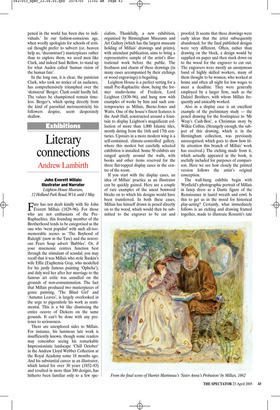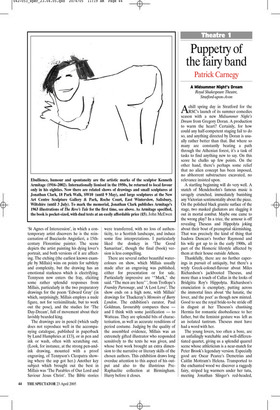Literary connections
Andrew Lambirth
John Everett Millais: Illustrator and Narrator Leighton House Museum, 12 Holland Park Road, W14, until 1 May Fate has not dealt kindly with Sir John Everett Millais (1829–96). For those who are not enthusiasts of the PreRaphaelites, this founding member of the Brotherhood tends to be categorised as the one who ‘went populist’ with such all-toomemorable scenes as ‘The Boyhood of Raleigh’ (now in the Tate) and the notorious Pears Soap advert ‘Bubbles’. Or, if your mnemonic centres function best through the stimulant of scandal, you may recall that it was Millais who stole Ruskin’s wife Effie (Euphemia Gray, who modelled for his justly famous painting ‘Ophelia’), and duly wed her after her marriage to the famous art critic was annulled on the grounds of non-consummation. The fact that Millais produced two masterpieces of genre painting, ‘The Blind Girl’ and ‘Autumn Leaves’, is largely overlooked in the urge to pigeonhole his work as sentimental. This is a bit like dismissing the entire oeuvre of Dickens on the same grounds. It can’t be done with any pretence to seriousness.
There are unexplored sides to Millais. For instance, his luminous late work is insufficiently known, though some readers may remember seeing his remarkable Impressionistic landscape ‘Chill October’ in the Andrew Lloyd Webber Collection at the Royal Academy some 18 months ago. And his substantial career as an illustrator, which lasted for over 30 years (1852–83) and resulted in more than 300 designs, has hitherto been familiar only to a few spe cialists. Thankfully, a new exhibition, organised by Birmingham Museums and Art Gallery (which has the largest museum holding of Millais’ drawings and prints), with attendant publication, aims to bring a representative sample of the artist’s illustrational work before the public. The freshness and charm of these drawings (in many cases accompanied by their etchings or wood engravings) is beguiling.
Leighton House is a perfect setting for a small Pre-Raphaelite show, being the former studio-home of Frederic, Lord Leighton (1830–96), and hung now with examples of works by him and such contemporaries as Millais, Burne-Jones and Watts. One of the house’s finest features is the Arab Hall, constructed around a fountain to display Leighton’s magnificent collection of more than 1,000 Islamic tiles, mostly dating from the 16th and 17th centuries. Upstairs in a more modern wing is a self-contained, climate-controlled gallery, where this modest but carefully selected exhibition is installed. Some 50 exhibits are ranged quietly around the walls, with books and other items reserved for the three flat-topped display cases in the centre of the room.
If you start with the display cases, an idea of Millais’ practice as an illustrator can be quickly gained. Here are a couple of rare examples of the uncut boxwood blocks on to which his designs would have been transferred. In both these cases, Millais has himself drawn in pencil directly on to the wood, which would then be submitted to the engraver to be cut and proofed. It seems that these drawings were early ideas that the artist subsequently abandoned, for the final published designs were very different. Often, rather than drawing on the block, a design would be supplied on paper and then stuck down on to the wood for the engraver to cut out. The engravers were mostly an anonymous band of highly skilled workers, many of them thought to be women, who worked at home and often all night for low wages to meet a deadline. They were generally employed by a larger firm, such as the Dalziel Brothers, with whom Millais frequently and amicably worked.
Also in a display case is an excellent example of the preliminary study — the pencil drawing for the frontispiece to ‘Mr Wray’s Cash-Box’, a Christmas story by Wilkie Collins. (Strangely enough, the subject of this drawing, which is in the Birmingham collection, was previously unrecognised; which goes to show how little attention this branch of Millais’ work has received.) The etching made from it, which actually appeared in the book, is usefully included for purposes of comparison. Here we see how closely the printed version follows the artist’s original conception.
The wall-hung exhibits begin with Wynfield’s photographic portrait of Millais in fancy dress as a Dante figure of the Renaissance in laurel wreath and cowl. Is this to get us in the mood for historical play-acting? Certainly, what immediately follows is an etching and drawing framed together, made to illustrate Rossetti’s tale ‘St Agnes of Intercession’, in which a contemporary artist discovers he is the reincarnation of Bucciuolo Angiolieri, a 15thcentury Florentine painter. The scene depicts the artist painting his dying lover’s portrait, and both versions of it are affecting. The etching (the earliest known example by Millais) wins on points for subtlety and complexity, but the drawing has an emotional starkness which is electrifying. Tennyson now enters the fray, eliciting some rather splendid responses from Millais, particularly in the two preparatory drawings for the poem ‘Edward Gray’ (in which, surprisingly, Millais employs a nude figure, not for verisimilitude, but to work out the pose), and the studies for ‘The Day-Dream’, full of movement about their lavishly bearded king.
The drawings are in pencil (which sadly does not reproduce well in the accompanying catalogue, published in paperback by Lund Humphries at £13), or in pen and ink or wash, often with scratching out. (Look, for instance, at the strong pen-andink drawing, mounted with a proof engraving, of Tennyson’s Cleopatra showing where the asp got her.) Another key subject which brought out the best in Millais was ‘The Parables of Our Lord and Saviour Jesus Christ’. The Bible stories were transferred, with no loss of authenticity, to a Scottish landscape, and induce some fine interpretations. I particularly liked the donkey in ‘The Good Samaritan’, though the final (book) version is less compelling.
There are several rather beautiful watercolours on show, which Millais usually made after an engraving was published, either for presentation or for sale. Particularly impressive are ‘“Mark,” she said. “The men are here” ’, from Trollope’s Framley Parsonage, and ‘A Lost Love’. The show ends on a high note, with Millais’ drawings for Thackeray’s Memoirs of Barry Lyndon. The exhibition’s curator, Paul Goldman, favourably compares these and I think with some justification — to Watteau. They are splendid bits of characterisation, as well as accurate renditions of period costume. Judging by the quality of the assembled evidence, Millais was an extremely gifted illustrator who responded sensitively to the texts he was given, and whose best work brought an extra dimension to the narrative or literary skills of the chosen authors. This exhibition draws long overdue attention to this aspect of his output and also to the illustrious PreRaphaelite collection at Birmingham. Hurry before it closes.




















































 Previous page
Previous page